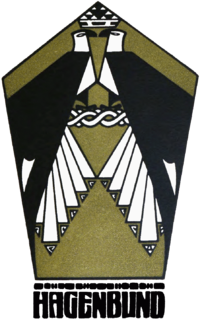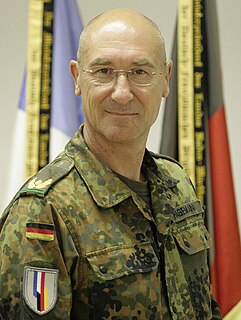Related Research Articles

A Generaloberst was the second-highest general officer rank in the German Reichswehr and Wehrmacht, the Austro-Hungarian Common Army, the East German National People's Army and in their respective police services. The rank was equal to a four-star full general but below a general field marshal. The rank was equivalent to a Generaladmiral in the Kriegsmarine until 1945 or to a Flottenadmiral in the Volksmarine until 1990. It was the highest ordinary military rank and the highest military rank awarded in peacetime; the higher rank of general field marshal was awarded only in wartime by the head of state. In general, a Generaloberst had the same privileges as a general field marshal.

A Burschenschaft is one of the traditional Studentenverbindungen of Germany, Austria, and Chile . Burschenschaften were founded in the 19th century as associations of university students inspired by liberal and nationalistic ideas. They were significantly involved in the March Revolution and the unification of Germany. After the formation of the German Empire in 1871, they faced a crisis, as their main political objective had been realized. So-called Reformburschenschaften were established, but these were dissolved by the National Socialist regime in 1935/6. In West Germany, the Burschenschaften were re-established in the 1950s, but they faced a renewed crisis in the 1960s and 1970s, as the mainstream political outlook of the German student movement of that period swerved to the radical left. Roughly 160 Burschenschaften exist today in Germany, Austria and Chile.

The Hagenbund or Künstlerbund Hagen was a group of Austrian artists that formed in 1899. The group's name derived from the name Herr Hagen, the proprietor of an inn in Vienna which they frequented.
The German parliament or Reichstag that was elected in the general election of May 1928 and sat until that of September 1930 was the fourth parliament of the Weimar Republic.

The Liebig Medal was established by the Association of German Chemists in 1903 to celebrate the centenary of Justus von Liebig. Since 1946 it has been awarded by the Society of German Chemists.

The Waldfriedhof Dahlem is a cemetery in Berlin, in the district of Steglitz-Zehlendorf on the edge of the Grunewald forest at Hüttenweg 47. Densely planted with conifers and designed between 1931 and 1933 after the plans of Albert Brodersen, it is one of Berlin's more recent cemeteries. Its graves include those of writers such as Gottfried Benn, composers such as Wolfgang Werner Eisbrenner and entertainers like Harald Juhnke, and put it among the so-called "Prominentenfriedhöfe" or celebrity cemeteries.

The Gottbegnadeten-Liste was a 36-page list of artists considered crucial to Nazi culture. The list was assembled in September 1944 by Joseph Goebbels, the head of the Ministry of Public Enlightenment and Propaganda, and Germany's supreme leader Adolf Hitler.

General of the Infantry is a former rank of the German Ground forces. Presently it is an appointment or position given to an OF-8 rank officer, who is responsible for particular affairs of training and equipment of the Bundeswehr infantry.

General der Panzertruppe was a General of the branch OF8 rank of the German Army, introduced in 1935. A General der Panzertruppe was a Lieutenant General, above Major General (Generalleutnant), commanding a Panzer corps.

General der Flieger was a General of the branch rank of the Luftwaffe in Nazi Germany. Until the end of World War II in 1945, this particular general officer rank was on three-star level (OF-8), equivalent to a US Lieutenant general.
The German Mathematical Society is the main professional society of German mathematicians and represents German mathematics within the European Mathematical Society (EMS) and the International Mathematical Union (IMU). It was founded in 1890 in Bremen with the set theorist Georg Cantor as first president. Founding members included Georg Cantor, Felix Klein, Walther von Dyck, David Hilbert, Hermann Minkowski, Carl Runge, Rudolf Sturm, Hermann Schubert, and Heinrich Weber.
Members of the Bavarian Maximilian Order for Science and Art, awarded to acknowledge and reward excellent and outstanding achievements in the fields of science and art. It is based in Bavaria, Germany.
References
- ↑ "Past presidents". Technical University of Munich . Retrieved 12 January 2021.